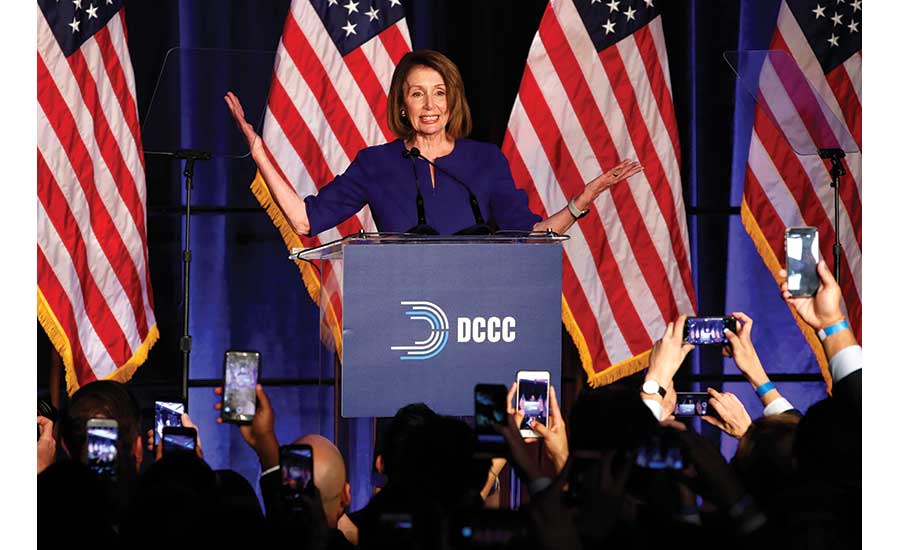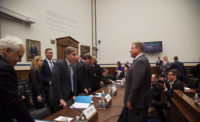In the wake of Democrats’ House takeover and Republicans widening their Senate majority in the midterm elections, talk has quickly revived about taking on infrastructure legislation in the new Congress. Construction industry officials welcome the pro-infrastructure rhetoric from congressional leaders and President Trump. But it remains to be seen whether the words will spark a bill that can make it through a divided 116th Congress. Funding the package remains the high hurdle.
House Minority Leader Nancy Pelosi (D-Calif.), who is seeking to be the chamber’s next speaker, declared at an election-night event, “We will deliver a transformational investment in America’s infrastructure to create more good paying jobs, rebuilding our roads, bridges, schools, water systems, broadband networks … housing and beyond.”
In the Senate, Mitch McConnell (R-Ky.), whom GOP colleagues already have chosen to remain majority leader, initially sounded encouraging notes. After speaking with Pelosi on Nov. 7, he told reporters, “The one issue Leader Pelosi and I have discussed this morning where there could be a possible bipartisan agreement would be something on infrastructure.”
Trump, too, brought up infrastructure. He said at a Nov. 7 press conference, “Hopefully we can all work together next year to continue delivering for the American people, including on economic growth, infrastructure, trade, lowering the cost of prescription drugs.”
Industry observers are encouraged by the upbeat comments. Steve Hall, American Council of Engineering Companies senior vice president, says that over the years, infrastructure has been “able to fly under the partisan radar.” Mike Strachn, a senior adviser at water-resources consulting firm Dawson & Associates, says, “What’s going for it is the widespread recognition that infrastructure needs to be addressed.” But Strachn, a former House transportation committee aide, adds, “The devil’s in the details, especially in how you pay for it.”
Infrastructure legislation won’t travel on easy street because of the amount of funds needed and parties’ differing approaches. Trump in February proposed what he said is a $1.5-trillion, 10-year infrastructure plan. It relies heavily on private investment and has only $200 billion in federal funding. In March, Senate Democrats proposed a 10-year, $1-trillion plan, all of it direct spending. Neither Trump’s nor Senate Democrats’ plan advanced in Congress.
Those interparty differences still seem to be there. Only a week after McConnell’s chat with Pelosi, he laid down a marker. He told reporters Nov. 14, “I think I can pretty safely say Republicans are not interested in doing a $900-billion stimulus, which we did at the beginning of the Obama era.” Much of the stimulus was appropriations. McConnell added, “So the question is, how are you going to pay for it? And that always becomes very challenging because there’s no sort of easy way to pay for infrastructure without impacting an awful lot of Americans.”
Rep. Peter DeFazio (D-Ore.), who is expected to be the new Transportation and Infrastructure Committee chair, wants to produce a major bill in 2019. He’s aiming for $500 billion for highways and transit, plus funds for airport and water projects. “Infrastructure has been delayed too long,” DeFazio told reporters on Nov. 7. “We’ve got to get it done,” he added.
DeFazio noted that it will be up to the Ways and Means Committee, not T&I, to find revenue for a House bill. But he says, “I’m open to any and all options on how we get real funds for infrastructure,” he said. “But it has to be real money.” He means direct federal funding, not private dollars.
For airport improvements, DeFazio wants to raise the passenger facility charge cap, which has been $4.50 since 2000. For Army Corps of Engineers dredging, he wants Congress to mandate spending the Harbor Maintenance Trust Fund balance.
Still, Hall is upbeat about prospects for infrastructure legislation, noting that Congress passed aviation and water bills this year. “What we’d like to do next year is much bigger obviously and a little tougher to do from the standpoint of cost and the political effort needed,” Hall says. But he adds, “If history is any judge, Congress has found a way to bridge those divides and get it done.”




Post a comment to this article
Report Abusive Comment